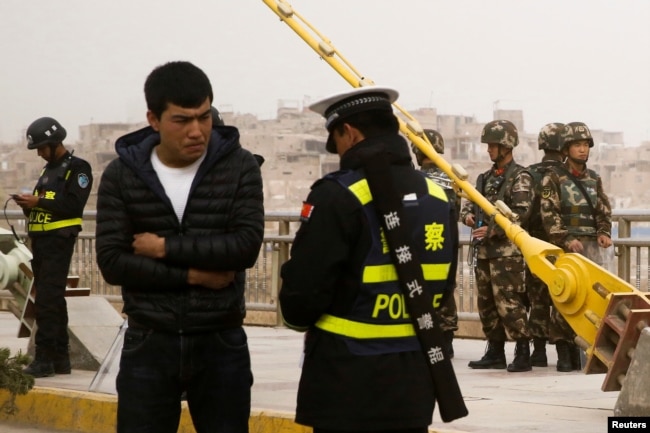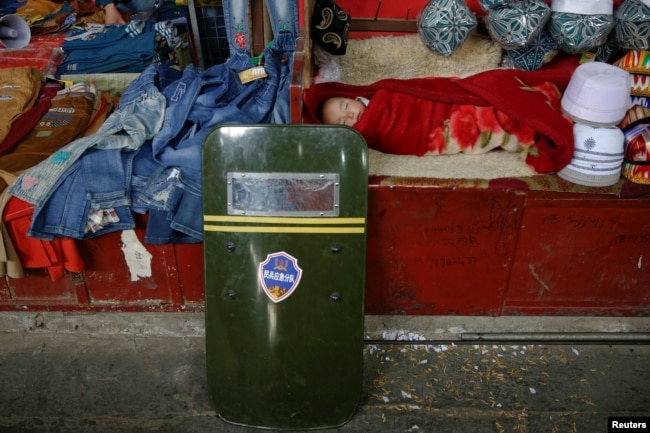KASHGAR/HOTAN, CHINA —
Three times a day, alarms ring out through the streets of China’s ancient Silk Road city of Kashgar, and shopkeepers rush out of their stores swinging government-issued wooden clubs.
In mandatory anti-terror drills conducted under police supervision and witnessed by Reuters on a recent visit, they fight off imaginary knife-wielding assailants. Armored paramilitary and police vehicles circle with sirens blaring.
China says it faces a serious threat from Islamist extremists in this far western Xinjiang region. Beijing accuses separatists among the Muslim Uighur ethnic minority there of stirring up tensions with the ethnic Han Chinese majority and plotting attacks elsewhere in China.
A historic trading post, Kashgar is also central to China’s One Belt, One Road (OBOR) Initiative, President Xi Jinping’s signature foreign and economic policy involving massive infrastructure spending linking China to Asia, the Middle East and beyond.
China’s worst fears are that a large-scale attack would blight this year’s diplomatic set piece, an OBOR summit attended by world leaders planned for Beijing in May.
State media say the drills, and other measures such as a network of thousands of new street-corner police posts, are aimed making everyone feel safer.

Men install a camera in a shopping street in the old town of Kashgar, Xinjiang Uighur Autonomous Region, China, March 23, 2017.
But many residents say the drills are just part of an oppressive security operation that has been ramped up in Kashgar and other cities in Xinjiang’s Uighur heartland in recent months.
Mass surveillance
As well as taking part in drills, shopkeepers must, at their own expense, install password-activated security doors, “panic buttons” and cameras that film not just the street outside but also inside their stores, sending a direct video feed to police.
For Uighurs like the owner of an online multimedia company facing one of Kashgar’s main streets, it is not about security, but mass surveillance.
“We have no privacy,” said the business owner who, like almost everyone Reuters spoke to in Kashgar, did not want to give his name. “They want to see what you’re up to.”
A Chinese security source, speaking on condition of anonymity, told Reuters the new security measures in Xinjiang were not politically motivated, but based on fresh developments and intelligence. He declined to elaborate.
The Xinjiang government and the State Council Information Office, which doubles as the Communist Party spokesman’s office, did not respond to requests for comment.

Security personnel keep watch in a street in Kashgar, Xinjiang Uighur Autonomous Region, China, March 23, 2017.
China routinely denies pursuing repressive policies in Xinjiang, and points to the vast sums it spends on economic development in the resource-rich region. Xinjiang’s gross domestic product last year rose 7.6 per cent, above the national average.
Decline in attacks
Since ethnic riots in the regional capital Urumqi in 2009, Xinjiang has been plagued by bouts of deadly violence.
The incidence of attacks reported in state media have actually declined markedly, both in frequency and scale, since a spate of bombings and mass stabbings in Xinjiang and southwestern Yunnan province in 2014.
But Chinese state media say the threat remains high and the Communist Party has vowed to continue what it terms its own “war on terror” against spreading Islamist extremism.
In Xinjiang, this can also be seen at weekly flag-raising ceremonies that Uighurs, a Turkic-speaking people who formed the majority in Xinjiang before an influx of Han Chinese, are required to attend to denounce religious extremism and pledge fealty under the Chinese flag.

A police officer checks the identity card of a man as security forces keep watch in a street in Kashgar, Xinjiang Uighur Autonomous Region, China, March 24, 2017.
At one such event witnessed by Reuters in Hotan, a former Silk Road oasis town 500 kilometers (300 miles) southeast of Kashgar, more than 1,000 people filed onto an open-air basketball court where party officials checked their names against an attendance list and inspected their dress and appearance.
“Best you take this off or I’ll send you to re-education,” said one female official, pulling back the black hijab worn by a middle-aged Uighur woman to expose her forehead and hair.
Hotan authorities offer 2,000 yuan ($290) rewards for those who report “face coverings and robes, youth with long beards, or other popular religious customs that have been radicalized,” as part of a wider incentive system that rewards actionable intelligence on imminent attacks.
Xinjiang lawmakers this week approved legislation extending a prohibition on “abnormal” beards and the wearing of veils in public places across the whole region. The new rules come into force on Saturday.
This month a video purportedly released by the Islamic State group showed Uighur fighters training in Iraq and vowing that blood would “flow in rivers” in China.
Party boss makes mark
The architect of the anti-terror drills and other new measures in Xinjiang is Chen Quanguo, who was appointed Communist Party boss in the region in August in what analysts said was an implicit endorsement of his hard-line management of ethnic strife in neighboring Tibet.

A child sleeps as a riot shield leans on a stall at the bazaar in Hotan, Xinjiang Uighur Autonomous Region, China, March 21, 2017.
Chen has made his mark swiftly, culminating last month in what state media described as mass “anti-terror” rallies across Xinjiang’s four largest cities involving tens of thousands of paramilitary troops and police.
One of Chen’s most visible initiatives has been to build thousands of what the authorities call “convenience police stations” across Xinjiang and to hire 30,000 officers to man them.
They are present on almost every intersection in Kashgar, typically just hundreds of meters apart, in what Chen calls a “grid-style social management” system he pioneered in Tibet.
Local state media have praised the initiative as a new benchmark in community-based policing. Critics, including Uighur and rights groups, say the real purpose of the convenience police stations is to spy on the population.
Citizens are encouraged to use the stations to charge their mobile phones, have a cup of tea or take shelter from the elements.
“I don’t know anyone who has been in there,” said one Han Chinese taxi driver, who wanted to be identified only by his surname, Huang, suggesting few have taken up the offer to huddle beside the riot police and soldiers who occupy the stations.
But Huang, reflecting the region’s simmering ethnic tensions, added that the increased security made him feel safer.
“Some people think it’s too much, that it’s just a few Uighurs,” he said. “But if they chop your family, then you’ll know.”
Economics vs. security
James Leibold, an expert on Chinese ethnic policy at La Trobe University in Melbourne, said the focus on security runs counter to Beijing’s goal of using the OBOR initiative to boost Xinjiang’s economy and improve its integration with the rest of China, because it would disrupt the flow of people and ideas.
“Those two are just fundamentally at odds,” he said.
Spending on security in Xinjiang is rising, jumping nearly 20 percent in 2016 to more than 30 billion yuan ($4.35 billion), according to state media.

A man walks along a street at night in the old town of Kashgar, Xinjiang Uighur Autonomous Region, China, March 23, 2017. Thousands of “convenience police stations” have been built across Xinjiang. They are typically just hundreds of meters apart in what party boss Chen Quanguo calls a “grid-style social management system.”
That can be seen in the metal detectors and airport-style security checks in place at major public areas, including Kashgar’s ancient Id Kah mosque, bazaars, malls and hotels.
Police spot checks of documents are carried out on pedestrians, with mobile phones inspected for extremist videos or use of banned chat applications like Telegram, WhatsApp and Twitter.
Mobile internet speeds have been slowed from 4G to 3G.
“There’s maybe 5,000 people making trouble, but the rest of us, 10 million of us, pay the price,” one Uighur man in Kashgar told Reuters.
Reuters was tailed closely by local police in Kashgar. A reporter returning to his hotel at 1 a.m. found officers waiting in the lobby.
When asked about the reason for the security, one of the officers said Kashgar’s preparations for OBOR were of paramount importance.
“When you see military and police vehicles patrolling the street in your country, what do you think it’s for?” he said.
“It’s for safety. Kashgar will be a hub for travel. Everything must be good.”
Source: voanews.com

Leave a Reply